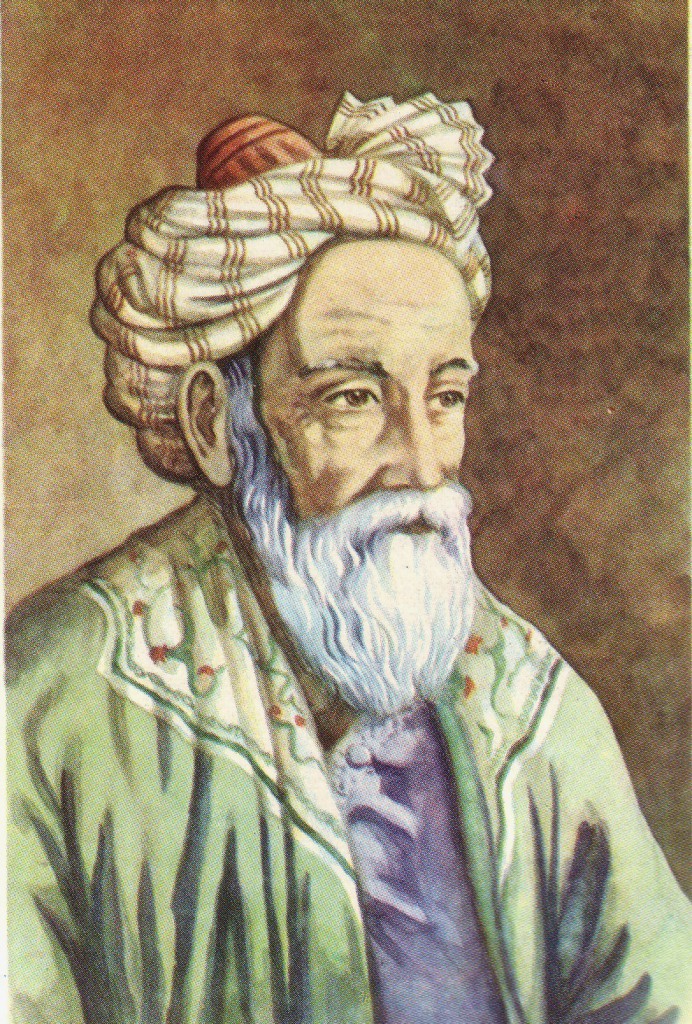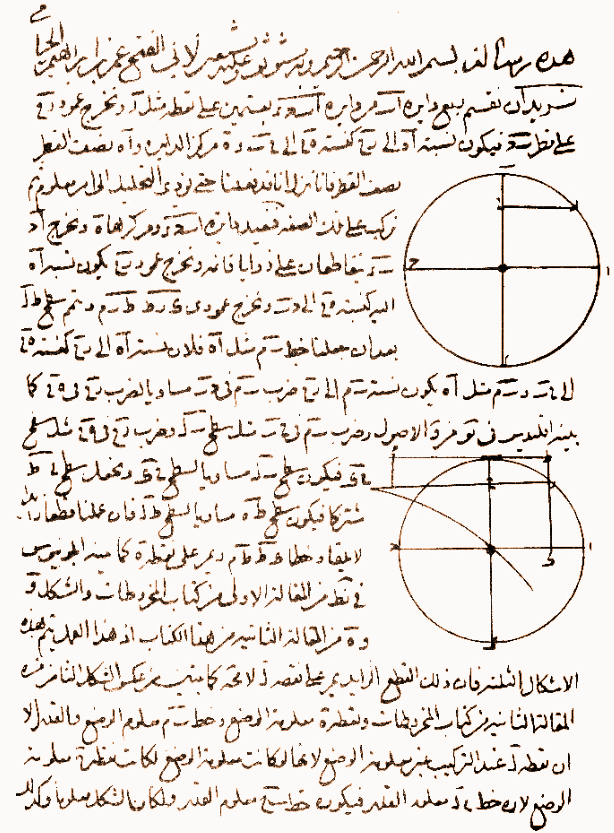
Omar Khayyám; born Ghiyāth ad-Dīn Abu’l-Fatḥ ʿUmar ibn Ibrāhīm al-Khayyām Nīshāpūrī (1048-1131)
On December 4, 1131, Persian mathematician, astronomer, philosopher, and poet, Omar Khayyam; born Ghiyāth ad-Dīn Abu’l-Fatḥ ʿUmar ibn Ibrāhīm al-Khayyām Nīshāpūrī, passed away. He is widely considered to be one of the most influential scientists of the middle ages. He wrote numerous treatises on mechanics, geography, mineralogy and astronomy.
“Whoever thinks algebra is a trick in obtaining unknowns has thought it in vain. No attention should be paid to the fact that algebra and geometry are different in appearance. Algebras (jabbre and maqabeleh) are geometric facts which are proved by propositions five and six of Book two of Elements.”
– Omar Khayyam, as quoted in “A Paper of Omar Khayyam” by A.R. Amir-Moez in Scripta Mathematica 26 (1963).
Early Years
Omar Khayyám was born in Nishapur, in Iran, then a Seljuq capital in Khorasan, which rivaled Cairo or Baghdad in cultural prominence in that era. He is thought to have been born into a family of tent-makers (khayyāmī “tent-maker”). The political events of the 11th Century played a major role in the course of Khayyam‘s life. The Seljuq Turks invaded southwestern Asia in the 11th Century and eventually founded an empire that included Mesopotamia, Syria, Palestine, and most of Iran. The Seljuq ruler Toghrïl Beg proclaimed himself sultan at Nishapur in 1038 and entered Baghdad in 1055. It was in this difficult unstable military empire, which also had religious problems as it attempted to establish an orthodox Muslim state, that Khayyam grew up.[1]
Khayyam studied philosophy at Naishapur. Throughout his life, Omar Khayyám was tireless in his efforts; by day he would teach algebra and geometry, in the evening he would attend the Seljuq court as an adviser of Malik-Shah I, and at night he would study astronomy and complete important aspects of the Jalali calendar. Khayyam himself described the difficulties for men of learning during this period in the introduction to his Treatise on Demonstration of Problems of Algebra (1070):
I was unable to devote myself to the learning of this algebra and the continued concentration upon it, because of obstacles in the vagaries of time which hindered me; for we have been deprived of all the people of knowledge save for a group, small in number, with many troubles, whose concern in life is to snatch the opportunity, when time is asleep, to devote themselves meanwhile to the investigation and perfection of a science; for the majority of people who imitate philosophers confuse the true with the false, and they do nothing but deceive and pretend knowledge, and they do not use what they know of the sciences except for base and material purposes; and if they see a certain person seeking for the right and preferring the truth, doing his best to refute the false and untrue and leaving aside hypocrisy and deceit, they make a fool of him and mock him.
The Principles of Algebra
In 1070 Omar Khayyam moved to Samarkand in Uzbekistan which is one of the oldest cities of Central Asia. There Khayyam was supported by Abu Tahir, a prominent jurist of Samarkand, and this allowed him to write his most famous algebra work, Treatise on Demonstration of Problems of Algebra. In this treatise, Khayyam laid down the principles of algebra, part of the body of mathematics that was eventually transmitted to Europe. There, he also wrote on the triangular array of binomial coefficients known as Pascal’s triangle. Furthermore, he gave a systematic discussion of the solution of cubic equations by means of intersecting conic sections. Perhaps it was in the context of this work that he discovered how to extend Abu al-Wafā’s results on the extraction of cube and fourth roots to the extraction of nth roots of numbers for arbitrary whole numbers n.[2]
Reform of the Calendar
Khayyam made such a name for himself that the Seljuq sultan Malik-Shāh invited him to Eṣfahān to undertake the astronomical observations necessary for the reform of the calendar. To accomplish this an observatory was built there, and a new calendar was produced, known as the Jalālī calendar. Based on making 8 of every 33 years leap years, it was more accurate than the present Gregorian calendar, and it was adopted in 1075 by Malik-Shāh. [2] Khayyam measured the length of the year as 365.24219858156 days. This shows an incredible confidence to attempt to give the result to this degree of accuracy. We know now that the length of the year is changing in the sixth decimal place over a person’s lifetime. Moreover, Khayyam’s result is outstandingly accurate. For comparison the length of the year at the end of the 19th century was 365.242196 days, while today it is 365.242190 days.[1]

“Cubic equation and intersection of conic sections” the first page of two-chaptered manuscript kept in Tehran University
Discussing Euclid
Khayyám wrote a book entitled Explanations of the difficulties in the postulates in Euclid’s Elements. The book consists of several sections on the parallel postulate (Book I), on the Euclidean definition of ratios and the Anthyphairetic ratio (modern continued fractions) (Book II), and on the multiplication of ratios (Book III). Khayyám refutes the previous attempts by other Greek and Persian mathematicians to prove the proposition of the parallel postulate. For two thousand years, many attempts were made to prove the parallel postulate using Euclid’s first four postulates. The main reason that such a proof was so highly sought after was that, unlike the first four postulates, the parallel postulate isn’t self-evident. If the order the postulates were listed in the Elements is significant, it indicates that Euclid included this postulate only when he realised he could not prove it or proceed without it. Unibtentionally, Khayyam thereby even made a contribution to non-euclidean geometry. In trying to prove the parallels postulate he accidentally proved properties of figures in non-euclidean geometries.
Besides Mathematics
Besides his achievements in mathematics or astronomy, Omar Khayyam also created wonderful poetry. Scholars believe he wrote about a thousand four-line verses or rubaiyat. It was introduced to the English-speaking world through the Rubáiyát of Omar Khayyám, which are poetic, rather than literal, translations by Edward FitzGerald. Ironically, FitzGerald’s translations reintroduced Khayyám to Iranians who had long ignored the poet. These poems consist of 4 lines of 13 syllables each with the rhyme scheme AABA or AAAA; the rhythm within each line is rather free. Rubaiyat had been popular in Persia since the 9th or 10th century as occasional verses extemporaneously recited by all classes of persons; they were used both to express a sort of hedonistic appreciation of life and also Sufi mystical experiences.[3] Of all the verses, the best known is the following:
The Moving Finger writes, and, having writ,
Moves on: nor all thy Piety nor Wit
Shall lure it back to cancel half a Line,
Nor all thy Tears wash out a Word of it.
BBC 4 – The Genius of Omar Khayyam, [7]
References and Further Reading:
- [1] O’Connor, John J.; Robertson, Edmund F., “Omar Khayyam“, MacTutor History of Mathematics archive, University of St Andrews.
- [2] Omar Khayyam in Britannica Online
- [3] “Omar Khayyam.” Encyclopedia of World Biography. 2004. Encyclopedia.com.
- [4] Euclid, the Father of Geometry, SciHi blog, January 30, 2015.
- [5] Omar Kayyam at Wikidata
- [6] Works by or about Omar Kayyam, at Wikisource
- [7] BBC 4 – The Genius of Omar Khayyam, Bristol Poetry Institute @ youtube
- [8] Howard Eves (1958). “Omar Khayyam’s Solution of Cubic Equations”, The Mathematics Teacher (1958), pp. 302–303.
- [9] Katz, Victor (1998). A History of Mathematics: An Introduction (2nd ed.). Addison-Wesley. p. 879
- [8] Timeline of Islamic mathematicians, via Wikidata






Pingback: Whewell’s Gazette: Year 2, Vol. #22 | Whewell's Ghost